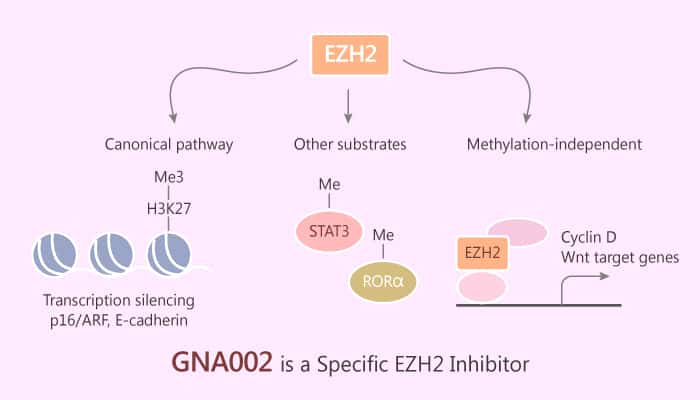Enhancer of zeste homolog 2 (EZH2) is a critical oncogene. Meanwhile, it is a promising drug target in human malignant tumors. H3K27Me3 functions as a suppressive marker of gene transcription. Previous studies have revealed that EZH2 are largely due to its ability to suppress the expression of a cohort of downstream tumor suppressor targets via H3K27 trimethylation-mediated epigenetic silencing. However, recent findings reveal that EZH2 can also exert its oncogenic roles independent of PRC2. It switches from a polycomb repressor to a transcriptional co-activator independent of its intrinsic histone methyltransferase activity. Gambogenic acid (GNA) is natural compound. Moreover, it is a potent anti-cancer agent for many types of human cancers. GNA002 is a highly potent, specific and covalent EZH2 inhibitor with an IC50 of 1.1 μM.

GNA002 is a highly potent, specific and covalent EZH2 inhibitor.
On the one hand, GNA002 can specifically and covalently bind to Cys668 within the EZH2-SET domain. It triggers EZH2 degradation through COOH terminus of Hsp70-interacting protein (CHIP)-mediated ubiquitination. Hence, GNA002 exerts its biological effect by specifically interacting with and inhibiting EZH2 enzymatic activities. In addition, it clearly inhibits the proliferation of numerous cancer cell lines with IC50s of 0.070 μM and 0.103 μM for MV4-11 and RS4-11. Secondly, it efficiently reduces EZH2-mediated H3K27 trimethylation in Cal-27 head and neck cancer cells. Thirdly, GNA002 reactivates polycomb repressor complex 2 (PRC2)-silenced tumor suppressor genes.
On the other hand, GNA002 significantly decreases the volumes of Cal-27-derived tumors. it reduces H3K27Me3 levels in tumor tissues. Furthermore, GNA002 also significantly suppresses the in vivo tumor growth derived from the xenografted A549 lung cancer cells, Daudi and Pfeiffer cells. GNA002 inhibits the aberrant oncogenic functions of EZH2, thus inhibiting tumor growth in vivo, at least in the xenograft experimental model.
In summary, GNA002, is a highly potent and covalent EZH2 inhibitor. It efficiently reduces EZH2-mediated H3K27 trimethylation, and reactivates PRC2-silenced tumor suppressor genes. Thus, it is a promising anti-cancer drug.
Reference:
Wang X, et al. EMBO J. 2017 May, 36(9):1243-1260.